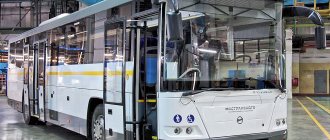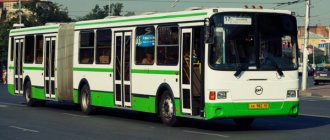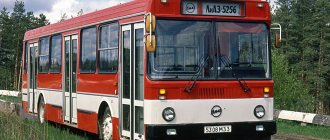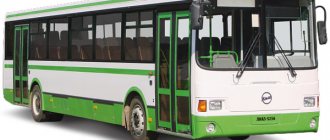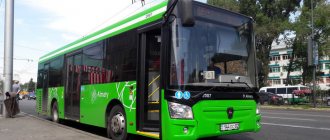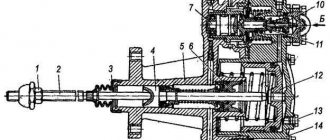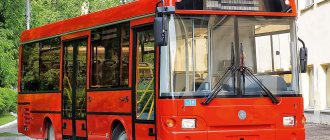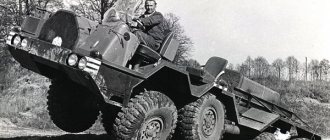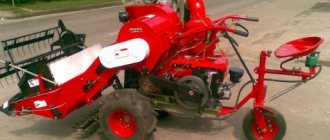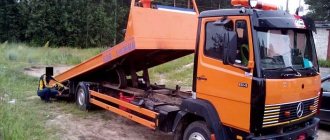Full description
LIAZ 5256 suburban
has received well-deserved recognition and popularity in Russia and other countries due to its operational and consumer characteristics. Thanks to advanced painting technologies, anti-corrosion treatment, and the use of galvanized sheets when lining the sides, the life of the body before through corrosion is at least 12 years.
The front and rear masks and the roof are made of fiberglass, which further increases the corrosion resistance of the body. A modern component base, the use of high-quality materials in the design of interior elements, soft adjustable / non-adjustable seats determine the optimal operation of the bus in the commuter cycle. When installing a gas engine (EURO-4), gas cylinders are located on the roof of the bus. From January 2012, the diesel modification of the bus will be equipped with engines meeting the EURO-4 environmental standard.
Advantages of LIAZ 5256 suburban
:
- — High reliability of components, assemblies and body;
- — Environmental standard Euro-3, 4;
- — High maintainability;
- — Improved consumer characteristics;
- - Affordable price;
- — Unification with other LIAZ models.
Guarantee period:
— 18 months or 100 thousand km (YaMZ);
— 18 months or 150 thousand km.
Technical characteristics of LIAZ 5256 suburban
| Body type | load-bearing, all-metal, carriage-type |
| Wheel formula | 4x2 rear |
| Body resource | 12 |
| Length Width Height | 11400/2500/3060 11400/2500/3322 |
| Ceiling height in the cabin, mm | 1950…2100 |
| Base | 5840 |
| Number/width of doors | 2/1300 |
| Min. turning radius, m | 11,5 |
| Curb/full weight, kg | 10372/16700; 10280/16600; 10750/17200 |
| Load on front/rear axle, kg | 5900/10800; 6000/10600; 6300/10900 |
| Total number of seats (including landing seats) | 88 (44) |
| Fuel tank capacity, l | 238 858 (8 cylinders of 97 + 1 shunting cylinder of 82) |
| Front axle | KAAZ 5256-3000012-10, with cross beam and drum brakes |
| Rear axle | RABA 718.23-3300 (i-5.44) double spaced or KAAZ 22.2400012 (i-5.6) RABA 718.23-3300 (i-5.44) double spaced |
| Steering gear | MAZ-64229 MAZ-64229 or ZF Servocom 8098 with power steering |
| Brake system | Pneumatic, dual-circuit, with ABS |
| Ventilation | Natural and forced |
| Heating system | Liquid, using the heat of the engine cooling system and an independent liquid heater |
| Tires | 275/70 R 22.5 |
Bus LiAZ-5256 – the last of the “Mohicans”?
We must pay tribute to the native of the USSR for his long service for the benefit of the public. Since 1986, more than 25,000 of these buses have rolled off the factory assembly line and traveled throughout the union.
Even now, a retiree of an earlier restyling can be found on city routes. True, he looks rather like a faded spot against the background of the new generation of bright brothers.
Drivers say that the white and green body of all these models has actually rotted and must be written off. But there are no complaints about imported power units, even after many years of service.
For example, on the balance sheet of one of the Tolyatti carriers there is a Soviet-built LiAZ-5256 with a 6-cylinder Caterpillar engine with a power of 340 “horses” and a volume of 6.8 liters.
According to the driver, despite its very shabby appearance, the bus moves off gently and smoothly. All the instruments on the panel are original, but like many other things in this bus they have long exceeded their service life. Transport takes a long time to warm up due to wear and tear on connections and components.
As for the interior, it has seen a lot: the imprint of long-term use is evident due to the deep cracks on the rough leatherette seats, the floor covering worn to holes, gaping scratches on the handrails and yellowing on the windows.
By the way, the fleet re-equipped the driver's cabin of the bus with its own resources, adding a glazed partition, like in the Ikarus. It became comfortable and passengers stopped being distracted while driving.
But even the improvements did not save the aging LiAZ. And he will soon go for analysis and press. And its place will be taken by the new MAZ.
Every year there are fewer and fewer such models, however, they can also be bought on online platforms at a reasonable price. For a used LiAZ-5256, the price, depending on the year of manufacture and modification, varies from 80,000 to 650,000 rubles.
“The price of gasoline is not interesting to me” “My fuel is natural gas” - now such signs and stickers on mobile vehicles are becoming more and more common. Why not? Gas is an environmentally friendly fuel of natural origin, which cannot be said about gasoline and diesel. Gas, or rather its combustion, has virtually no effect on the atmosphere. In addition, this fuel provides good speed. So what's the problem?
Actually, there are no problems. A year ago, the Likinsky Automobile Plant presented several buses powered by compressed natural gas, including the LiAZ-525657 model. LiAZ 525657 has been released recently, but has already managed to win its audience. So what are the advantages of running on gas and diesel?
The answer is simple and clear - in traction. As a rule, diesel fuel provides greater power and traction when burned, but no less force must be applied to compress it. Buses with such engines are cost-effective to use on routes with numerous obstacles - hills, difficult areas. However, in a big city with, as a rule, a fairly even surface, they only pollute the environment (although much less than gasoline, but still), because traction is not needed here, is it?
It cannot be said that the traction force generated by burning gas is small - it is enough for a sharp start of the LiAZ-525657 bus when necessary. But driving uphill when the cabin is fully loaded will be more difficult for the LiAZ 525657 bus than for its diesel “colleague”.
However, one thing that cannot be taken away is the affordable price. It is probably no longer a secret that it is impossible to predict how long diesel and gasoline prices will continue to rise - their prices are rising without stopping. But oil reserves are coming to an end (there are still some, but they have already been calculated and “used up in absentia”). An alternative is needed. And besides, natural gas is cheaper than other types of fuel - why not use it?
The designers of the Likinsky Automobile Plant, taking into account the mental disorder of our people (after all, not all gas stations have clean gas), decided to play it safe and use imported engines of the famous Cummins brand in LiAZ 525657 buses. These power units have a large margin of safety (12-year service life), reliability and high build quality.
The LiAZ-525657 bus, despite the fact that it runs on gas, can pay for itself in a much shorter period of time, because the advantages here are not only in relatively cheap energy. The payback is directly affected by the capacity of the cabin, isn't it?
After all, the more passengers the LiAZ 525657 bus can accommodate, the more profit the owner will receive. The LiAZ-525657 bus can accommodate 110 people with relative comfort. 23 of them will be lucky enough to sit on comfortable seats with anti-vandal coating.
LiAZ-525657 buses are unpretentious in operation and economical to operate. The previous models of the Likinsky Bus Plant had many shortcomings that had a serious impact on the owner’s pocket. For example, an insufficiently powerful and unreliable engine, a quickly rotting body and other troubles.
In the new LiAZ 525657 models, the problems have been solved. All current LiAZ buses can “show off” a particularly wear-resistant body - through corrosion will appear only after 12 years. It saves money, doesn't it?
In addition, as mentioned earlier, LiAZ-525657 buses use Cummins engines with a safety margin of 12 years. Gears are now switched automatically by a reliable and high-quality unit - the Allison automatic transmission. All this makes the LiAZ-525657 bus a durable and high-quality passenger vehicle. Which is a strong argument in favor of buying a LiAZ 525657 bus.
As official representatives of the Likinsky Automobile Plant, we give you the opportunity to buy a LiAZ-525657 bus in various configuration options, with warranties provided by the manufacturer, on the most favorable terms. In our company, LiAZ-525657 buses are sold at manufacturer prices.
LiAZ-5256 was discontinued: the last Soviet city bus left
Last week in the city of Chusovoy, Perm Territory (I’ll tell you about what I did there separately), I met several early urban LiAZ-5256s, and in excellent condition. Before this, I hadn’t come across one for several years. And just like that, coincidentally: a couple of days later it became known that the GAZ group had discontinued its last modification, and with it its semi-low-floor brother 5293. But although this bus did not live up to the glory of its predecessor, LiAZ-677, it stood still the conveyor belt is thirty-five years old, survived the hard years and gave life to many domestic buses.
The history of its appearance is also complicated and tortuous - and began already twenty years before the start of mass production. Within the framework of the CMEA (Council for Mutual Economic Assistance) of the socialist countries, among other cooperation, our bus industry worked closely with the Hungarian one. For example, it was the USSR that supplied the famous Ikarus with front axles, and in return received Raba drive axles.
The first-born of the future family of low-floor buses Mir 11-630
And so in 1971, our Ministry of Automotive Industry concluded an agreement with the Hungarian Ministry of Metallurgy and Mechanical Engineering on the creation of a unified family of city buses for the CMEA countries. It was planned to create a whole range of urban vehicles, single and articulated, ranging from seven to 18 meters in length. On our side, this was done by the Union Bus Design Bureau in Lvov, on the Hungarian side by the Autokut Institute and the same Ikarus. The first prototype of the future bus was embodied in metal in 1974. It was called Mir 11-630, the numbers indicated the length (11 m) and floor height (630 mm).
At that time, it was an advanced design: a flat floor located at the rear and shifted to the left of the longitudinal axis of the YaMZ-740 diesel engine (the future KAMAZ of the same name), an automatic transmission, a portal rear axle, air suspension, and a complex-shaped windshield made of four elements.
At the same time, it was slowly decided where and how it would be released in the USSR. By 1977, they decided on the location - the task was transferred to the Likinsky plant and funds were allocated for reconstruction and preparation for production. In 1979, two more samples were produced in Lvov, already close to the serial one and changing their name to the familiar LiAZ-5256. As usually happened, they were simplified taking into account the requirements of technologists. The engine took its usual place in the center in the stern, which is why the floor level rose to 740 mm and a step appeared at the rear. The length of the bus was 11,400 mm, passenger capacity - 117 people.
A prototype during testing at the Dmitrovsky NAMI test site
Traditionally, in the late USSR, as in a fairy tale, “things were not done soon.” Preparations for production at LiAZ dragged on for five years: at first they even seemed to start building a new building, but then they changed their minds. The plant frankly did not want to switch to the new bus; it was quite satisfied with the established process of producing “Lunokhovers”-677. The ministry also had its opponents, and, as usual, its subcontractors often let us down. Thus, the Lvov residents produced automatic transmissions in insufficient quantities, and it turned out to be not very reliable, so production buses were more often equipped with a KAMAZ manual gearbox.
The Belarusian version Neman-5201 was produced from 1992 to 2003
Only in 1985 the plant produced the first batch, and from the next year it began small-scale production. LiAZ-5256 could have become the most popular bus in the USSR, but it was late, hitting the main assembly line of the plant only in March 1991. Then the well-known leapfrog in the country began, the Bus Association appeared, and the production of 5256 from vehicle kits started in many cities (Bor, Tosno, Ryazan, Sterlitamak, Kirov, Yakhroma, Chimkent and others). Volzhanin and the Belarusian Neman started with its assembly, and GolAZ and NefAZ made it.
There were many special assignments at base 5256, including fire-fighting headquarters
A fire at the KAMAZ engine plant in 1993 forced an urgent search for a replacement; cars with diesel engines of all available brands appeared: YaMZ, Raba-MAN, TMZ, ZIL, Skoda, Mercedes, Cummins. The optimal versions turned out to be versions with a YaMZ-236 or Caterpillar diesel engine. But output continued to decline: there was no money in the country.
Coming close to bankruptcy, in 2000 LiAZ was bought by the Russian Buses group, and the story of the “city dweller” continued. Under the new owner, the LiAZ-5256 remained the main model in the production program. By that time, various intercity, tourist and special options had been developed - from mobile canteens to mobile customs posts. In total, the program included more than a hundred modifications. To improve the quality of bodies, an anti-corrosion treatment and painting line was put into operation, consisting of eight cataphoresis baths, twelve painting and ten drying chambers.
“Semi-low-floor” 5293 was no different in appearance from the classic. Almost a fifth of them work in St. Petersburg
In 2005, a semi-low-floor brother, LiAZ-5293, appeared, displacing the classic on the assembly line. However, due to its lower price, the 5256 was popular in poor cities throughout the country, and both cars were produced in parallel until the very end. During the entire production period, about 25 thousand LiAZ-5256 buses were produced.
